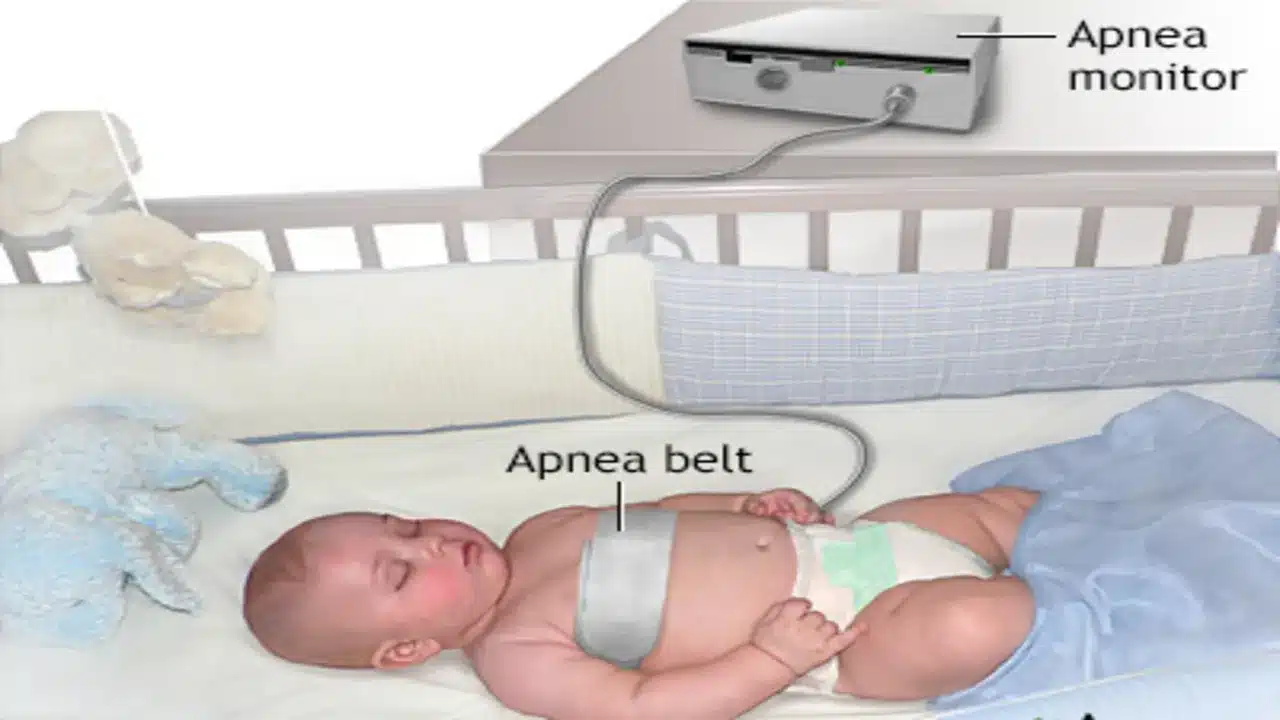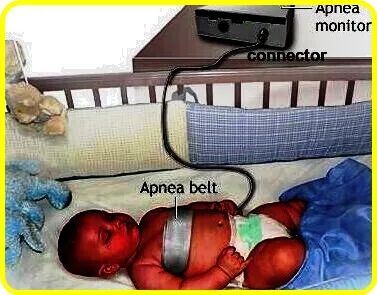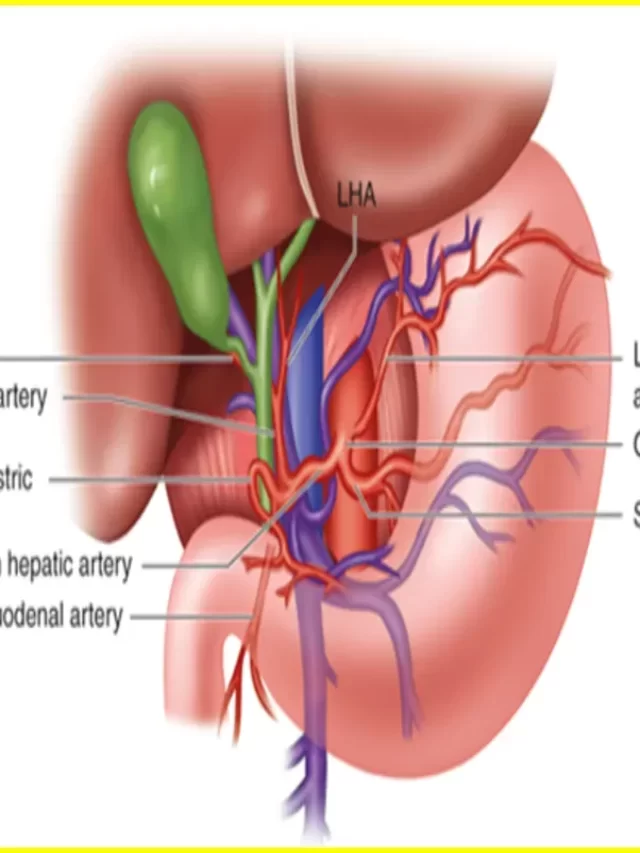
Apnea monitors
Apnea monitors detect the cessation of breathing (apnea) in infants and adults who are at risk of respiratory failure and alert the parent or attendant to the condition.

Some prolonged respiratory pauses result in low oxygen concentration levels in the body, which can lead to irreversible brain damage and, if prolonged, death.
The components of apnea monitors depend specifically on the type. However, in general, they compose of a set of sensors that obtain information on different physiological parameters.

This information pass to a micro-computer system, which analyses the sensors’ information and determines if apnea is occurring.
Sleep Apnea Monitor
A sleep apnea monitor is a medical device used to diagnose and monitor sleep apnea, a sleep disorder characterized by pauses or shallow breathing during sleep. These pauses can last from a few seconds to minutes and may occur several times throughout the night, causing sleep disturbances and potential health risks.
Sleep apnea monitors typically come in two forms:
- In-lab sleep study equipment: Sleep apnea is usually diagnosed through an overnight sleep study in a sleep lab or clinic. During the study, various sensors and monitoring devices are attached to the patient’s body to record data such as breathing patterns, heart rate, oxygen levels, brain activity, and body movements. These devices may include:
- Polysomnography (PSG) equipment: measures brain waves, eye movements, heart rate, oxygen levels, and muscle activity.
- Pulse Oximeter: Measures the blood oxygen saturation level.
- Respiratory Effort Belt: Tracks chest and abdominal movements during breathing.
Trained sleep technologists analyze the collected data to determine the presence and severity of sleep apnea.
2. Home Sleep Apnea Testing (HSAT) Device: In some cases, a simplified version of sleep apnea monitoring can be done at home using a portable device. Home sleep apnea testing is usually recommended for individuals with a high likelihood of moderate to severe sleep apnea. HSAT devices are more convenient and cost-effective than in-lab studies, but provide limited data compared to complete PSG. These devices usually include:
- Portable Monitoring Devices: These are compact devices that typically measure parameters such as airflow, respiratory effort, oxygen levels, and heart rate.
It is important to note that sleep apnea monitoring devices are typically used for diagnosis and initial evaluation. Continuous monitoring of sleep apnea is not usually done at home, but may be done in a sleep lab if needed for treatment evaluation or adjustment.
If you suspect that you have sleep apnea or are experiencing symptoms, it is important to consult with a health care professional who can guide you through the diagnostic process and recommend appropriate monitoring equipment or sleep studies for your condition. can recommend.

Working Principles of Apnea Monitor
Monitors that use impedance pneumographic detect small changes in electrical impedance as air enters and leaves the lungs and as the blood volume changes in the thoracic cavity.
Mattress-type motion sensors typically monitor changes in the capacitance or resistance of a mattress transducer. Pneumatic abdominal sensors also detect breaths as changes in pressure.
More direct methods of respiration detection monitor the airflow into and out of the lungs; these include thermistors, proximal airway pressure sensors, and carbon dioxide (CO2) sensors.
The apnea monitor attaché to the patient using the appropriate sensor for the measurement. Once connected, as the patient breathes, the unit monitors different body parameters. If an alarm sounds, the operator must attend to the patient immediately.
Article About:- Health & fitness
Article About:- Medical Technology
Article About:- Sports
Infant Apnea Monitor
An infant apnea monitor, also known as a baby apnea monitor or infant breathing monitor, is designed to monitor an infant’s breathing and alert caregivers if there are pauses in breathing or abnormal breathing patterns. is the equipment. These monitors are commonly used in hospitals, neonatal intensive care units (NICUs), and sometimes in home settings for infants at risk for apnea or other breathing-related problems.
Here are some of the key features and components of an infant apnea monitor:
- Sensor pads or belts: These are usually placed on the baby’s chest or abdomen and detect movement or lack of movement. They can feel the expansion and contraction of the chest or abdomen during breathing.
- Apnea alarm: The monitor is programmed to sound an alarm if it detects an interruption of breathing or an abnormal breathing pattern, such as slow or shallow breaths. The alarm is designed to alert caregivers or parents to take immediate action.
- Audio and visual alerts: In addition to audible alarms, many baby apnea monitors have visual indicators such as flashing lights to provide additional alerts.
- Data Recording: Some monitors have the ability to record and store data about the baby’s breathing patterns, alarms, and other relevant information. This data can be useful for health professionals to analyze the infant’s condition and make informed decisions.
- Mobility: Infant apnea monitors may come as portable, battery-powered devices, allowing monitoring of the infant at various locations, such as during transport or at home.
It is important to note that infant apnea monitors are typically used in specific medical situations where infants are at higher risk of apnea or other breathing problems, such as premature infants or infants with certain medical conditions. The decision to use an infant apnea monitor should be made in consultation with a healthcare professional who can assess the infant’s specific needs and prescribe appropriate monitoring equipment.
An infant apnea monitor should not take the place of proper medical care and supervision. If you have trouble breathing in your child or suspect a health problem, it is important to seek immediate medical attention from a healthcare provider.
How to work apnea monitor
The only sure way to rid yourself of the condition for good is to either lose weight or have surgery to remove excess tissue from the palate or throat. Because CPAP and oral appliances work well, but they’re not cures for sleep apnea.
A pulse oximeter attached to your finger or earlobe measures your blood oxygen saturation. Single-lead electrocardiography or ECG use for this measuring your pulse rate.
There are nasal prongs and a sensor to provide nasal oxygen that measure the pressure changes during breathing in sleep.
What is an apnea monitor
An apnea monitor is a medical machine used to monitor heart rate and breathing at home. Apnea is breathing that slows or stops for whatever reason.
The monitor automatically sounds an alarm when your baby’s heart rate or breathing slows or stops.
This apnea monitor tracks the breathing and heart rate of babies even while they are sleeping. Monitors may sound like a good idea to concerned parents.
Are breathing monitors worth it
Critical organizations have reviewed research on apnea monitors and found no evidence that they affect the prevention of SIDS in healthy children.
An at-home sleep apnea test may be appropriate for you if you have symptoms of obstructive sleep apnea, such as: A sleep partner reports that you snore, snore, or gasp while sleeping.
Apnea Monitor for Adults
For adults with sleep apnea or other breathing disorders, several types of apnea monitors and devices are available. These devices are primarily focused on monitoring and managing sleep apnea during sleep. Here are some common options:
- Continuous Positive Airway Pressure (CPAP) Machines: CPAP machines are one of the most commonly prescribed treatments for obstructive sleep apnea (OSA). They provide a steady stream of pressurized air through the nose or a mask worn over the nose and mouth, keeping the airway open during sleep. CPAP machines often include built-in monitoring features that track usage data, such as mask leak rates, apnea events, and pressure levels.
- Bilevel positive airway pressure (BiPAP) machines: BiPAP machines work in the same way as CPAP machines, but provide two levels of pressure: a higher level during inhalation and a lower level during exhalation. This feature can be beneficial for people who have difficulty breathing against high CPAP pressures. BIPAP machines may also include monitoring features to track treatment effectiveness and compliance.
- Auto-adjusting positive airway pressure (APAP) machines: APAP machines automatically adjust the pressure delivered based on the person’s breathing patterns throughout the night. They continuously monitor and adapt pressure to provide the minimum pressure needed to keep the airway open. APAP machines are useful for patients who experience various levels of airway obstruction during sleep.
- Wearable sleep trackers: Various wearable devices, such as smartwatches or wristbands, offer sleep tracking features that can provide insight into sleep quality, including detecting possible signs of sleep apnea. These devices typically use accelerometers or optical sensors to monitor motion, heart rate, and oxygen saturation levels. While they can provide valuable data, they are not diagnostic tools and should not replace a medical evaluation.
It is important to note that the diagnosis and treatment of sleep apnea should be done under the guidance of a healthcare professional. They can recommend the most appropriate monitoring and treatment options based on a person’s specific needs and the severity of sleep apnea.

What would be a reason to monitor for apnea in the home.
This is because it is considered normal for everyone to have 4-5 apnea in an hour. It is also normal if your AHI varies from night to night.
In addition to tracking disease activity, some monitors also track statistics such as your child’s breathing, heart rate, oxygen saturation level, and temperature. Some even provide sleep analytics that help you gain insight into your baby’s sleeping patterns.
At the present time, even the most advanced of smartwatches and fitness trackers can only detect the possibility of sleep apnea, and recommend that you seek further diagnosis. Only a sleep study analyzed by a board-certified doctor can diagnose obstructive sleep apnea.
Risks of an Apnea Monitor
Stick-on electrodes can occasionally irritate your child’s skin. This is usually not a big problem. If you have an electrical power supply problem or you have a power problem, this monitor may not work unless it has a backup battery.
Ask your home care company if your monitor has a battery backup system. If so, learn how to charge the battery.
This Apnea Monitor is a machine This monitor is small and portable. Which is used to monitor the baby’s heart rate and breathing after coming home.
Apnea is breathing that slows or stops for whatever reason. The monitor sounds an alarm when your baby’s heart rate or breathing slows or stops.

Apnea Monitor Advantage and Disadvantage
| Advantage of Apnea Monitor | Disadvantage of Apnea Monitor |
| The Device Will Notify You | There is pain in the skin due to the electrodes |
| Help You Identify Apneic Children | Battery backup problem |
| Detects Variations in Heart Rate and Breathing | It will not work if there is no electricity |
| Assist Avoid Over diagnosis |
FAQ
What does apnea mean on a hospital monitor
In a hospital setting, the “apnea” displayed on the monitor refers to the absence or cessation of breathing for a significant period of time. Hospital monitors are equipped with sensors that detect various physiological parameters, including breathing, heart rate, blood oxygen levels, and more.
What is an apnea monitor for adults
Apnea monitors for adults are devices used to monitor breathing patterns and detect apnea events or other respiratory abnormalities in adult individuals. These monitors are primarily used in clinical or home settings for adults who have been diagnosed with sleep apnea or other breathing disorders.
What is an apnea monitor
An apnea monitor, also known as a respiration monitor, is a medical device used to monitor a person’s breathing patterns and detect apnea (temporary cessation of breathing) or other abnormal respiratory events. . These monitors are commonly used for infants, children, or adults who are at risk of experiencing apnea or other breathing problems.









